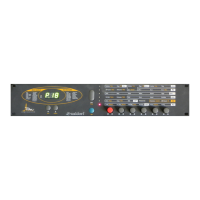User’s Manual Pulse • PulsePlus
25
8.4 Low-frequency Oscillators (LFOs)
In addition to the main oscillators, the Pulse is equipped with two low-frequency oscillators
which are also used for modulation purposes. The acronym "LFO" has become the standard
term for low-frequency oscillators.
LFO 1
Similar to the oscillators, the first LFO generates periodic waveshapes with variable
frequency and waveshape. These are determined by the following parameters:
LFO1 Speed 0...127 Determines the frequency. A value of 0 is equivalent to
0.0008 Hz, i.e. one cycle in two minutes. A value of
127 is equivalent to 261.6 Hz, i.e. the frequency of the
middle C on a MIDI keyboard (C3). Within the value
range of 16 to 127, the LFO is scaled in semitone
increments. For instance the value 115 is equivalent to
130.8 Hz or C2. 10 is equivalent to G1 or 98 Hz.
If you use a MIDI Sync Mode via the LFO1 Shape parameter, you
can determine the LFO speed by the note length in a range from thirty-
second notes to 8 bars. Also dotted values are availiable. As long as
the arpeggiator is active, the LFO will synchronise to the internal
clock. However, if the arpeggiator itself is in MIDI Sync, the LFO uses
the external clock too.
LFO1 Shape Determines the type of waveshape to be generated.
Sawtooth
Triangle
Sine
Example: 2 bars
Example: 1/8 dotted
Example: 1/4

